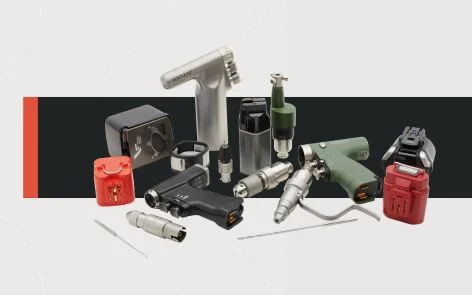Cost Savings and Sustainability: The Positive Eco-Impact of Top-tier Instrument Maintenance and Reprocessing
You can ensure surgical instrument performance, reliability, and longevity and protect the environment with expert maintenance, care, and sustainable practices.
Veterinarians and their clients care about climate effects. Increasingly, we all want eco-friendly pet care.1, 2 At the same time, well-maintained and properly processed surgical instruments enhance the quality of your work and help you deliver exceptional care.
This is why Movora proudly offers heirloom-quality reusable instruments, premium reprocessing tools, as well as cutting-edge continuing education along with free care and maintenance for surgical instruments covered by the Spectrum and VetSpectrum warranty. Discover how our eco-friendly, dependable products and services can help you deliver outstanding care, contribute to sustainability, and save money.
Preserve Resources
While disposable instruments may fit specific situations and don’t require reprocessing, studies suggest they’re worse for the environment than reusable instruments across a number of measures.3,4,6,7 Efficiently processing well-maintained surgical equipment designed for reuse minimizes resource consumption and pollution.
Properly maintained and reprocessed surgical instruments last longer, cut replacement costs, and conserve resources. Veterinary clinics reduce the environmental impact of instrument manufacturing and waste disposal by preserving and reusing equipment.
Minimize Global Impact
Sustainable and local supply chains mitigate environmental impact. It takes a large, global footprint to produce and then eliminate disposable surgical instruments. Well-maintained, quality instruments last for years to minimize waste.

Conserve Energy
Manufacturing consumes energy and emits carbon. Surgical instruments commonly consist of stainless steel, titanium, and other metals. Producing surgical equipment and medical devices depletes metals, drains energy, and creates carbon emissions. Studies suggest continuous manufacturing of single-use surgical instruments contributes to the environment-damaging impact of disposable items.3, 4, 5, 7
Veterinary facilities can conserve resources and reduce the energy demand and raw materials needed to manufacture surgical instruments by establishing routine preventive maintenance and excellent reprocessing protocols. They’ll also indirectly lower their carbon footprint.
Cost Savings
Repeatedly purchasing disposable instruments can lead to higher long-term costs for veterinary practices. Proper reprocessing and preventive maintenance make quality, reusable instruments last longer, so practices won’t have to spend money constantly replacing disposable instruments.
Better Performance
Well-maintained, high-quality instruments ensure consistent performance during procedures. They enhance patient safety and reduce the likelihood of surgical errors that could lead to additional medical waste or the need for further medical intervention 8, 9.
Instrument Care: Our Commitment to You
Movora provides preventive care and repair, including sharpening and re-jawing of needle holders.
Movora provides preventive care and repair, including sharpening and re-jawing of needle holders. While the Movora Instrument Repair Center services all brands of surgical instruments, savings are even greater for users of Spectrum and VetSpectrum surgical instruments – they’re FREE.
Spectrum and VetSpectrum Veterinary Surgical Instruments have a Limited Lifetime Repair Warranty. During the usable lifetime of your Spectrum or VetSpectrum instruments, our Movora Instrument Repair Center experts will restore them at no additional cost. When an instrument is sent in for service near the end of its usable life, we’ll let you know it’s time to repurchase.
Movora helps you properly maintain your instruments with our accredited online sterilization technique and reprocessing courses for the entire staff. We also offer instrument cleaning and conditioning solutions to keep your instruments in peak condition.
End on a Green Note
Deliver outstanding care, protect the environment, and save money with EverGreen Containers. In a world of disposable surgical instruments and products, prioritizing instrument care, reprocessing procedures, and preventive maintenance maximizes sustainability, extends instrument reliability, and reduces replacement costs. Protecting your surgical instruments helps the environment by cutting waste and conserving resources.
Read our catalog or contact your Movora rep to learn how we can help support sustainability goals for veterinary clinics of all sizes. Learn how to debunk the myths of instrument care and cleaning with this online course from Movora Education. Or explore the services of the Movora Instrument Repair Center.
1. Kramer CG, McCaw KA, Zarestky J, Duncan CG. Veterinarians in a Changing Global Climate: Educational Disconnect and a Path Forward. Frontiers in Veterinary Science. 2020;7doi:10.3389/fvets.2020.613620
2. Mitzner D. Pet Care Companies Bank On Sustainability As Consumer Trends Shift. Forbes. 2023. https://www.forbes.com/sites/dennismitzner/2023/08/08/pet-care-companies-bank-on-sustainability-as-consumer-trends-shift/?sh=2d2720057c9b
3. Drew J, Christie SD, Tyedmers P, Smith-Forrester J, Rainham D. Operating in a Climate Crisis: A State-of-the-Science Review of Life Cycle Assessment within Surgical and Anesthetic Care. Environmental Health Perspectives. 2021;129(7):076001. doi:10.1289/ehp8666
4. Bhutta, MF. “Our over-reliance on single-use equipment in the operating theatre is misguided, irrational and harming our planet.” The Annals of The Royal College of Surgeons of England, vol. 103, no. 10, Nov. 2021, pp. 709–712, https://doi.org/10.1308/rcsann.2021.0297.
5. Cohen, Eva S., et al. “Environmental impact assessment of reusable and disposable surgical head covers.” JAMA Surgery, vol. 158, no. 11, 1 Nov. 2023, p. 1216, https://jamanetwork.com/journals/jamasurgery/fullarticle/2809266.
6. Keil, Mattis, et al. “The impact of switching from single-use to Reusable Healthcare products: A Transparency Checklist and systematic review of life-cycle assessments.” European Journal of Public Health, vol. 33, no. 1, 26 Nov. 2022, pp. 56–63, https://doi.org/10.1093/eurpub/ckac174.
7. Pearlstein, Alex M. “Environmental Impact of Reusable and Disposable Surgical Forceps Consumption at the Hospital of The University of Pennsylvania.” Https://Presentations.Curf.Upenn.Edu/Sites/Default/Files/Poster_upload/2021-04/Pearlstein%20Thesis%20Poster.Pdf, 2021, https://presentations.curf.upenn.edu/sites/default/files/poster_upload/2021-04/Pearlstein%20Thesis%20Poster.pdf. Accessed 7 Jan. 2025.
8. Van den Berg, Nadia, et al. “Instrumentation failure during microlaryngoscopy.” Journal of Surgical Case Reports, vol. 2022, no. 4, 1 Apr. 2022, https://doi.org/10.1093/jscr/rjac181.
9. Kaiser, Herbert J., et al. “Spotting, Staining, and Corrosion of Surgical Instruments.” Infection Control Today, 1 Oct. 2000, www.infectioncontroltoday.com/view/spotting-staining-and-corrosion-surgical-instruments.
2. Mitzner D. Pet Care Companies Bank On Sustainability As Consumer Trends Shift. Forbes. 2023. https://www.forbes.com/sites/dennismitzner/2023/08/08/pet-care-companies-bank-on-sustainability-as-consumer-trends-shift/?sh=2d2720057c9b
3. Drew J, Christie SD, Tyedmers P, Smith-Forrester J, Rainham D. Operating in a Climate Crisis: A State-of-the-Science Review of Life Cycle Assessment within Surgical and Anesthetic Care. Environmental Health Perspectives. 2021;129(7):076001. doi:10.1289/ehp8666
4. Bhutta, MF. “Our over-reliance on single-use equipment in the operating theatre is misguided, irrational and harming our planet.” The Annals of The Royal College of Surgeons of England, vol. 103, no. 10, Nov. 2021, pp. 709–712, https://doi.org/10.1308/rcsann.2021.0297.
5. Cohen, Eva S., et al. “Environmental impact assessment of reusable and disposable surgical head covers.” JAMA Surgery, vol. 158, no. 11, 1 Nov. 2023, p. 1216, https://jamanetwork.com/journals/jamasurgery/fullarticle/2809266.
6. Keil, Mattis, et al. “The impact of switching from single-use to Reusable Healthcare products: A Transparency Checklist and systematic review of life-cycle assessments.” European Journal of Public Health, vol. 33, no. 1, 26 Nov. 2022, pp. 56–63, https://doi.org/10.1093/eurpub/ckac174.
7. Pearlstein, Alex M. “Environmental Impact of Reusable and Disposable Surgical Forceps Consumption at the Hospital of The University of Pennsylvania.” Https://Presentations.Curf.Upenn.Edu/Sites/Default/Files/Poster_upload/2021-04/Pearlstein%20Thesis%20Poster.Pdf, 2021, https://presentations.curf.upenn.edu/sites/default/files/poster_upload/2021-04/Pearlstein%20Thesis%20Poster.pdf. Accessed 7 Jan. 2025.
8. Van den Berg, Nadia, et al. “Instrumentation failure during microlaryngoscopy.” Journal of Surgical Case Reports, vol. 2022, no. 4, 1 Apr. 2022, https://doi.org/10.1093/jscr/rjac181.
9. Kaiser, Herbert J., et al. “Spotting, Staining, and Corrosion of Surgical Instruments.” Infection Control Today, 1 Oct. 2000, www.infectioncontroltoday.com/view/spotting-staining-and-corrosion-surgical-instruments.



